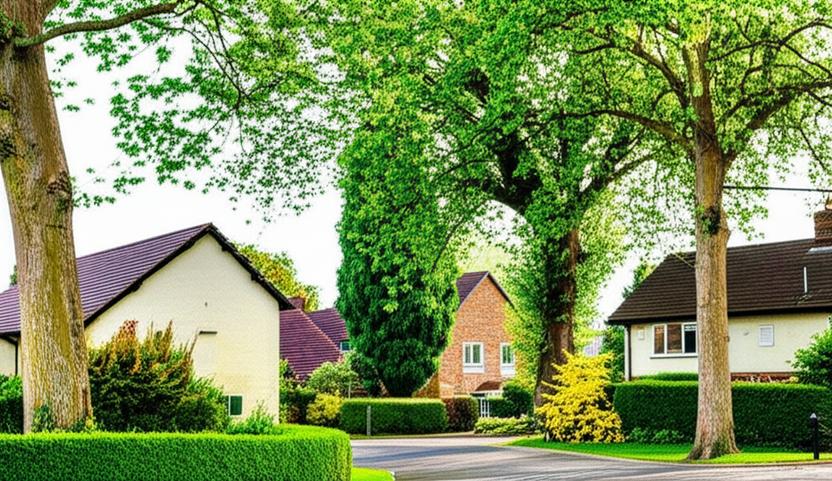Ever scratched your head wondering about the rules for tree height near homes here in the UK? You’re not alone! It’s a really common misconception that there’s some magic legal limit on just how tall a tree can get when it’s close to your house. This misunderstanding often leads to a bit of head-scratching, and sometimes, even a few neighbourly spats.
The plain truth is, there isn’t a single, straightforward legal “maximum tree height” across the UK. Instead, we’re talking about a whole tangled web of regulations, individual homeowner duties, and specific legal frameworks that dictate how trees are managed, especially when they’re chilling close to our properties.
Seriously, getting a handle on these legal nuances is super important for every homeowner. Without this knowledge, you could accidentally break a rule, end up with a hefty bill for tree damage, or find yourself in a tricky dispute with next door. This guide is here to untangle those regulations, giving you the lowdown you need to navigate any tree-related wobbles, dodge conflicts, and keep your property and your peace of mind intact.
The Core Principle: Is There a Maximum Tree Height in the UK?
Understanding the “No Maximum Height” Rule
Okay, so unlike garden fences, which often have pretty clear height restrictions, trees in the UK are generally free to grow as tall as nature intended, without a legal cap. That means a tree on your land – or your neighbour’s, for that matter – can technically reach its full species-specific height, as long as it’s not actually causing a specific legal nuisance or falling under certain protective orders.
This freedom is awesome for the environment, allowing mature trees to thrive and offer all their ecological benefits. But here’s the kicker: it also puts a big emphasis on us, the homeowners, to be responsible. What does this “no maximum height” rule really mean? Well, it means you’ve got a fair bit of say over the trees on your patch, which can be a real source of pride and add some lovely curb appeal. However, it also means your neighbours can’t just demand a tree be chopped down just because it’s towering over their garden. The focus totally shifts from arbitrary height limits to sorting out actual, tangible problems that tall trees might be causing.
Why the Perception of Limits Exists
So, if there’s no general height limit, why do so many of us *think* there is? This perception usually comes from specific legal frameworks that are designed to deal with issues *caused* by tall trees, rather than the tree’s height itself. For instance, a tree might not have a height limit, but if its branches are dangling over your neighbour’s roof, its roots are messing with foundations, or a dense hedge is blocking out all the sun, then those specific situations can absolutely lead to legal intervention. It’s these particular circumstances and the solutions they offer that make many people believe there’s a blanket restriction on how tall a tree can be.
These misunderstandings just get more muddled by the complexities of planning laws, conservation efforts, and individual property rights. People often mix up the rules for protected trees or those really high hedges with a universal height restriction, which, as we’ve seen, isn’t the case. The law is actually more interested in the *impact* a tree has than its exact stature.
Key Legal Frameworks Governing Trees Near UK Homes
Tree Preservation Orders (TPOs): Essential Protections for UK Trees
Let’s talk about **Tree Preservation Orders (TPOs)**. These are basically legal tools local planning authorities use to shield specific trees or entire woodland areas because they’re considered valuable for the public’s enjoyment and environmental health. So, if a tree on your property has a TPO attached to it, it’s a big no-no to cut it down, top it, lop it, uproot it, deliberately damage it, or destroy it without getting explicit permission from your local council first. These rules are super strict, and even just a bit of minor pruning needs an application to the council.
Ignoring a TPO can lead to some pretty serious headaches, including unlimited fines and legal action. For example, did you hear about those two folks in Welwyn Garden City? They ended up with £27,500 in legal costs for illegally felling protected trees, as WeBuyAnyHome reported. So, before you even think about touching a tree, make sure you double-check with your local council to see if a Tree Preservation Order UK is in play. Trust me, this simple step could save you a world of legal and financial pain!
Trees in Conservation Areas: Added Layers of Protection
It’s not just TPOs you need to think about. Trees that live within designated Conservation Areas also get a special extra layer of protection. If you’re planning any work on a tree in one of these areas, you’re required to give your local council six weeks’ notice beforehand. This “six-week notice” period essentially gives the council time to review your proposed work and decide if the tree is important enough to warrant its own TPO.
During these six weeks, the council can figure out if the tree really adds to the character and look of the conservation area. If it does, they might just issue a TPO to protect it permanently. This system is a clever way to make sure those valuable trees in historically or aesthetically important spots aren’t just removed or damaged without proper thought.
The “Right to Light” Act 1959: Protecting Your Natural Daylight
Now, this is an interesting one: the “Right to Light.” It’s a legal easement that can safeguard the amount of natural daylight pouring into a property through a specific opening, like a window or a glass door. Typically, you acquire this right after enjoying 20 years of continuous, uninterrupted light to a “defined aperture.” But here’s an important distinction: this right isn’t about guaranteeing direct sunshine or a totally clear view; instead, it protects the flow of daylight to existing openings.
Making a claim under the Rights of Light Act 1959 can be a bit complex, often needing specialist surveyors to figure out how much an obstruction (like, yes, a tall tree) is actually impacting the light. The surveyor will assess if the remaining light falls below a legally acceptable level. It’s a powerful tool, no doubt, but remember, it’s different from just wanting more sunlight and relies on meeting very specific legal criteria.
High Hedges Legislation: Addressing Overgrown Hedges, Not Single Trees
Got a problem with an unruly hedge that’s really causing trouble? The Anti-social Behaviour Act 2003 brought in some specific laws known as the High hedges legislation UK. This law is all about “high hedges” – meaning two or more evergreen or semi-evergreen trees or shrubs that are taller than two meters and are seriously impacting someone’s reasonable enjoyment of their home or garden. Crucially, this legislation doesn’t apply to single trees, even if they’re super tall.
If you’re dealing with a high hedge issue, your first move should always be to try and sort it out nicely with your neighbour. If a friendly chat doesn’t work, you can then make a formal complaint to your local council. They’ll investigate, and if your complaint is upheld, they can issue a notice requiring the hedge owner to trim it down. Just be aware that there’s usually a fee involved for this complaint process.
Homeowner Rights and Responsibilities Regarding Trees
Your Rights: Trimming Overhanging Branches
Good news for UK homeowners: you actually have a common law right to cut back any branches from a neighbour’s tree that are hanging over your property line. This right lets you trim those encroaching bits of the tree, giving you back full enjoyment of your land. However, there are some important catches here that you absolutely need to respect to avoid any legal bother.
You must NOT trespass onto your neighbour’s land to do the trimming. And you’ve got to make sure your pruning doesn’t harm the overall health of the tree. Also, remember that any branches you cut legally still belong to the tree owner, so you should offer them back or get your neighbour’s permission to dispose of them. Most importantly, before you even think about cutting, double-check if the tree is protected by a TPO or is in a conservation area, because if it is, you’ll need the council’s go-ahead.
Your Responsibilities: Duty of Care and Liability
Every homeowner in the UK has a “duty of care” to make sure the trees on their property aren’t posing a foreseeable risk to other people or their property. This means you’re responsible for keeping your trees healthy and stable. If a tree on your land falls or drops branches and causes damage or injury, you could be held liable if it can be proven that you were negligent in your duty of care.
This liability really highlights why regular tree inspections and maintenance are so important. Negligence could mean ignoring obvious signs of disease, decay, or instability that any reasonable person would have spotted. So, understanding neighbour tree laws UK isn’t just about knowing what you can do, but also about upholding your responsibilities to prevent potential harm and those pesky disputes.
Trees on Your Own Property: What You Can (and Can’t) Do
Generally speaking, if a tree is totally on your property and isn’t protected by a TPO or in a conservation area, you’re pretty much free to prune it or even remove it entirely. This gives homeowners the flexibility to manage their garden spaces as they please. However, even with unprotected trees, there are still a few things to keep in mind.
You absolutely must be mindful of protected species, like nesting birds or bats, which are legally protected from disturbance. If a tree has a nest or a bat roost, you’d need to wait until the nesting season is over or get special licenses before doing any work. For big or tricky tree removal or pruning jobs, it’s always a smart move to get a professional assessment and execution from a qualified arborist to ensure everything is done safely and legally.
Addressing Common Tree-Related Issues and Disputes
Dealing with Dangerous Trees: Identifying Risks and Reporting
Spotting a potentially dangerous tree early is critical to preventing accidents and property damage. What should you look out for? Think significant leaning, cracks in the trunk or major branches, obvious areas of decay or rot, leaves that are discoloured or shedding too early, and even raised soil around the base of the tree, which can signal root instability. WeBuyAnyHome points out that falling trees tragically cause around five fatalities annually and damage loads of properties.
If you’re worried about a tree – whether it’s on your land, your neighbour’s, or public property – you need to act. For trees on your own land, get a professional arborist in for an assessment. If it’s your neighbour’s tree, have a chat with them first about your concerns. If it’s on public land, report it to your local council, as they have the authority to investigate and demand action for dangerous trees.
Preventing and Managing Property Damage: Subsidence and Drains
Tree roots can be real troublemakers, causing significant property damage, especially subsidence, particularly in areas with clay soils. Clay soils are a bit like sponges – they expand when wet and shrink when dry. Large trees can make this worse by sucking up huge amounts of water from the soil, causing it to shrink and potentially undermine foundations. This is a big deal in the UK; tree root-induced clay shrinkage accounts for roughly 60% of valid subsidence claims in a typical year, as reported by the Gemini Online Research Agent.
And it’s not just subsidence! Tree roots can also block or crush underground drains and even damage paving or driveways. To steer clear of tree root damage subsidence UK, it’s super important to think carefully about planting distances. The National House Building Council (NHBC) suggests planting trees on clay soils at a minimum distance of three-quarters of their maximum mature height. Regular professional tree surveys can help you assess risks and recommend the right preventative steps.
Resolving Neighbour Tree Disputes Amicably
Tree disputes with neighbours can be a real headache, but honestly, loads of them can be sorted out nicely with a bit of open communication. Your very first and best step should always be to talk to your neighbour about what’s bothering you. Try to approach the conversation calmly and constructively, explaining the issue and maybe even suggesting a few solutions. Sometimes, your neighbour might not even realise their tree is causing a problem!
If a direct chat doesn’t quite do the trick, mediation services can be a fantastic option. A neutral third party can step in to help facilitate a discussion and work towards a solution that everyone can agree on. Throughout any dispute, it’s always smart to keep a record of all your messages and conversations; it can be really helpful if things escalate.
When to Involve Your Local Council
While having a chat is always the preferred first step, there are specific times when getting your local council involved is simply necessary. This includes issues related to Tree Preservation Orders (TPOs), trees in conservation areas, complaints under the high hedges legislation, or when a tree on public land looks genuinely dangerous. The council actually has the power to investigate and enforce regulations in these situations.
The process for involving the council changes depending on the specific issue, and yes, there might be fees for formal complaints, like those concerning high hedges. It’s important to understand what the council’s role and limits are; generally, they step in when there’s a clear breach of regulation or a significant public safety concern, rather than for purely aesthetic squabbles.
Choosing the Right Trees: Avoiding Future Problems Near Your Home
Tree Species to Avoid Near Foundations
When you’re planning your garden, picking the right tree species and planting them in sensible spots can save you a ton of trouble down the line. Some tree species are notorious for their aggressive root systems or high water demand, making them pretty unsuitable for planting close to house foundations, especially if you’re on clay soils. We’re talking about trees like Poplar, Oak, Willow, Eucalyptus, Cypress, and Foxglove trees.
For example, Poplars and Willows are incredibly thirsty, and their roots will actively hunt for water, often to the detriment of your drainage systems. Oaks, while magnificent, develop huge root systems and can grow to massive sizes, making them problematic if they’re too close to buildings. Eucalyptus trees are also fast growers with a high thirst, plus they’ve got a habit of dropping branches, which can be a risk. BBC Gardeners’ World Magazine wisely advises against planting these particular species too close to homes to avoid nightmares like subsidence and drain damage.
Safe Planting Distances and Considerations for Clay Soils
To keep the risk of Maximum Height of Trees Near Houses UK causing subsidence to an absolute minimum, especially on those tricky clay soils, sticking to recommended planting distances is crucial. General advice suggests planting trees at a distance that’s at least equal to, or ideally even greater than, their mature height from any building foundations. For species that are super thirsty or have aggressive roots, you’ll want to aim for even greater distances.
On shrinkable clay soils, where subsidence is a bigger gamble, the National House Building Council (NHBC) suggests a minimum planting distance of three-quarters of the tree’s maximum mature height. When you’re planning your garden, always think about the tree’s mature size, not just how tiny it is as a sapling! Professional landscape designers or arborists can give you tailor-made advice based on your specific soil type and property.
Recommended Trees for UK Residential Gardens
For UK residential gardens, especially if you’re tight on space or close to your house, choosing smaller, less invasive tree species is a really smart move. These trees can still bring loads of beauty, shade, and ecological perks without posing the same risks as their larger, thirstier cousins. Some great choices include ornamental cherries (think varieties like *Prunus ‘Kanzan’* or *Prunus serrula*), crab apples (*Malus* species), rowan (*Sorbus aucuparia*), and those gorgeous Japanese maples (*Acer palmatum* varieties).
These types of trees typically have more contained root systems and grow to a manageable size, making them perfect for urban and suburban settings. They offer seasonal delights with their flowers, fruit, and stunning autumn colours, enhancing your garden without threatening your property’s foundations or getting you into a kerfuffle over the Maximum Height of Trees Near Houses UK.
Conclusion: Navigating Tree Laws for a Harmonious Home
So, it’s pretty clear now, isn’t it? While there isn’t one single, grand legal maximum height for trees near houses here in the UK, the rulebook is anything but simple! Instead, we’ve got a whole series of complex laws, orders, and common law rights in play, all primarily designed to manage the sorts of issues that can pop up from tall trees and to protect our valuable green assets. From Tree Preservation Orders to the ins and outs of high hedges legislation and the “Right to Light” Act, really understanding these frameworks is absolutely crucial for any homeowner.
Getting through these tree laws requires a proactive approach and a clear grasp of both your rights and your responsibilities. Being proactive with management, keeping up with regular tree maintenance, and, perhaps most importantly, having good relationships with your neighbours are the keys to avoiding disputes and making sure your living environment stays harmonious. By staying informed, you can make responsible choices about the trees on your property and effectively handle any concerns about those on neighbouring land.
What to Do Next: Your Action Plan
To make sure you’re totally compliant and to protect your property, always chat with your local council for specific info on Tree Preservation Orders or conservation area status in your neighbourhood. For professional assessments of tree health, pruning, or removal services, we highly recommend getting advice from qualified and insured arborists. And hey, why not share this comprehensive guide with your neighbours? It can really help foster a better understanding of tree laws for everyone and hopefully head off any potential disputes before they even begin!










